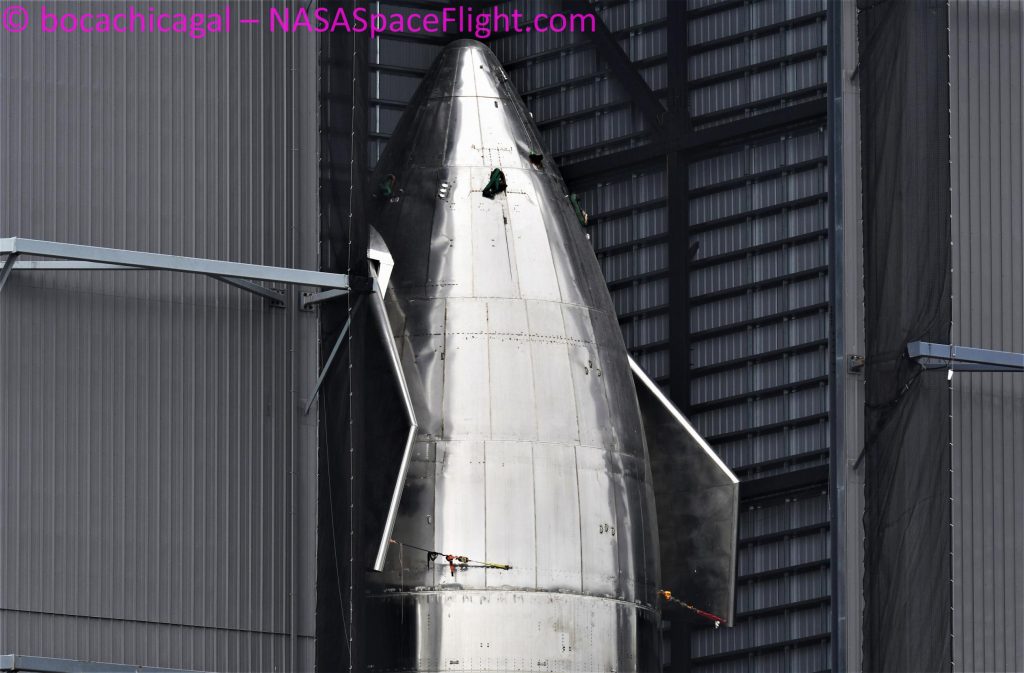4.03.2021
STARSHIP SN10 HIGH-ALTITUDE FLIGHT TEST
































Quelle: SpaceX











Quelle: YouTube space.com
+++
SpaceX's Starship rocket lands but then explodes

The SpaceX company has managed to land one of its Starship prototypes at the end of a high-altitude test flight.
Serial Number 10 (SN10) touched down in Boca Chica, Texas - in contrast to its predecessors SN8 and SN9, which crashed into the ground.
But that wasn't the end of the story. The next-generation space vehicle put down heavily on its extended legs.
A fire then developed around its base and eight minutes later SN10 blew itself apart on the landing pad.
Nonetheless, SpaceX will be hugely encouraged by the test. The prototype successfully executed its in-flight manoeuvres and managed to make a reasonably soft landing. These milestones will give the company confidence as it moves forward with the ambitious concept.
SpaceX envisages Starships replacing its existing Falcon rockets.
These vehicles carry out regular missions - both crewed and uncrewed - for the US space agency (Nasa), the American military, and other commercial concerns.
But CEO Elon Musk says the new 50m-tall Starship will do it all, bigger and better - orbiting satellites and carrying passengers, both around the Earth and to off-world destinations such as the Moon and Mars.
Indeed, he's promised a lunar excursion in 2023 to the Japanese online fashion retail billionaire Yusaku Maezawa.
Mr Maezawa will travel in a Starship with eight other individuals, and opened applications this week to anyone who might be interested in joining his "dearMoon" venture.
Wednesday's high-altitude test proceeded much like the previous prototype flights.
The uncrewed SN10 left its launch mount at the Boca Chica R&D facility, and rose vertically on the thrust of three methane-burning Raptor engines.
These power units shut down in sequence as the target height of roughly 10km (6.2 miles) was approached, with the vehicle then leaning over into the horizontal for the drop to the ground.
This belly-flop descent, controlled by large flaps at either end of the vehicle, is intended to simulate how future, operational Starships will re-enter the Earth's atmosphere from orbit, presenting a large surface area to the direction of travel to scrub off speed.
The vehicle is supposed to transition back to a tail-down configuration just before reaching the surface.
SN8 and SN9 couldn't manage it. Both vehicles failed to adopt the correct orientation and reduction in speed.
SN10, however, got it right, slowing rapidly and putting down on a concrete pad. A major contribution to the success was undoubtedly the decision this time to re-light all three Raptors ahead of landing, ensuring at least two engines were available to provide the necessary braking thrust.
"Third time's a charm," said John Insprucker, the SpaceX webcast commentator.

But all was not perfect. SN10 was leaning. Its stubby legs deployed at touchdown appeared to have collapsed. And as water hoses tried to extinguish a fire at the base of the vehicle, it suddenly leapt upwards and exploded.
SpaceX already has other prototypes in various stages of assembly at Boca Chica, up to SN19 currently.
The Starship will eventually launch atop a booster called Super Heavy. This too is in build at Boca Chica.
It will feature perhaps 28 Raptors, producing more than 70 meganewtons (16 million lbs) of thrust - about double that of the mighty Apollo Saturn 5 rocket, which sent men to the Moon.
When combined, both parts of the new SpaceX system - Starship and Super Heavy - will stand about 120m tall on the launch pad.
The two elements are being designed to be fully reusable, making propulsive returns at the end of each mission.
SpaceX hopes Starship can be involved in Nasa's return to the Moon this decade. Starship is currently in competition with a number of other aerospace companies to provide a landing system to take astronauts down to the lunar surface.
Quelle: BBC
----
Update: 9.03.2021
.
SpaceX wants its next Starship prototype ready to launch next week

NASASpaceflight.com reports that SpaceX – already scheduled to transport a new Starship to the launch pad on Monday, March 8th – wants that prototype ready to launch as early as next week.
According to the same report, SpaceX – having already installed three Raptor engines on Starship serial number 11 (SN11) – aims to more or less wrap up all qualification testing by the end of the week. No different than the test campaigns that all other flightworthy Starships had to pass before being cleared for launch, that process includes – at minimum – a good cryogenic proof test and a combined wet dress rehearsal (WDR) and static fire.

Still, it’s not entirely impossible. If SpaceX can borrow from the most efficient Starship launches and test campaigns its completed and combine them all with a few new, unspecified efficiencies, it’s reasonable to conclude that Starship SN11 could be ready to fly near the end of next week (around March 19th). More specifically, SpaceX would have to complete a successful static fire on the first try within a week of SN11’s scheduled March 8th rollout, followed by a brisk two or three-day turnaround for a launch attempt.
While not impossible, it’s safe to say that that scenario is unlikely. Nevertheless, assuming SpaceX continues to find ways to expedite preflight processing like it has with SN8, SN9, and SN10, it’s reasonable to assume that Starship SN11 could be ready for an inaugural launch attempt as early as the last week of March.
All the above ignores the possibility that SpaceX will choose to physically modify Starship SN11 to mitigate the possibility of some or all aspects of Starship SN10’s hard landing and subsequent explosion from recurring. If that is the plan, those changes will have to be done at the launch site after Starship SN11’s scheduled Monday, March 8th rollout.
Quelle: TESLARATI
